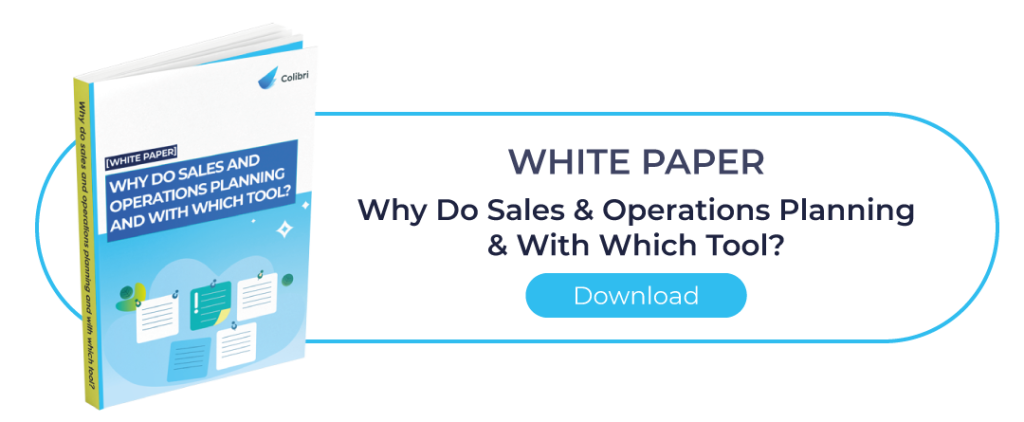Implementing an S&OP process is becoming a priority for companies of all sizes, from large groups to SMEs. S&OP brings together all the functions of a company to rigorously plan its activities so that actions are consistent with demand, sales targets and available resources.
The S&OP process, or Sales and Operations Planning (SOP), enables decisions to be coordinated and variations to be anticipated. The result? Easier inventory management, faster flows, avoided delays and a better in-house atmosphere!
However, if you want to get the most out of S&OP, it’s best to avoid common mistakes. Here are 8 to avoid!
#1 Not including all departments in the process
S&OP involves all departments in the company. At every stage, it’s essential to ensure that everyone involved is on board. Finance, sales, marketing, human resources, supply chain, logistics… Decisions must be taken on the basis of assumptions and resources defined by each department, right up to management level. This global visibility favors the implementation of effective actions, tailor-made to fit the company’s reality. What’s more, good collaboration helps toavoid dysfunctions linked to miscommunication between departments, and to defuse potential conflicts.
#2 Not meeting regularly
The whole point of the S&OP process lies in its regularity and repetitiveness: it’s about updating assumptions with all stakeholders to reach collegial decisions. To achieve this, meetings should be held at least once a month, so that a representative from each department can feed back relevant information and any variations that need to be taken into account.
To ensure that these meetings run smoothly, an S&OP project manager can be appointed. A good software program can also be used to maintain this regularity and ensure that the tasks required for the success of the process are carried out upstream.
#3 Don’t work by exceptions
Working on a regular monthly basis means that certain families can be worked on specifically in response to an unusual situation or a variation in KPIs.
It’s also an opportunity to adapt your annual plan, because while it’s impossible to work on all your families every month, you can nevertheless anticipate that certain products will play a key role in the medium-term plan. Conversely, other families may be relegated to the background: dealing with Christmas products in January, for example, is of limited interest. Working by exception allows us to adapt to the seasonal nature of our products.
In this way, S&OP makes it possible to work at different levels of granularity and focus on what really matters. This approach can be applied to product families, as well as to individual products. For example, it may make sense to focus more regularly on top products, which account for 80% of sales and require special attention.
#4 Be content with a short-term vision
The S&OP process brings key players together around the same table. It’s important to take advantage of this context to update assumptions and identify short-, medium- and long-term challenges. It’s the perfect opportunity toalign all departments with strategic decisions, and to make decisions that will structure the company. Planning for the long term offers a capacity for anticipation: it gives teams time to adapt to the established organization, and means you don’t have to work in a hurry.

#5 Lack of clear KPIs
Alongside this medium- and long-term vision, it is necessary to audit the process and monitor the effectiveness of its implementation. Companies may rely on KPIs linked to forecast reliability or stock coverage, for example… Tracking the evolution of these structuring KPIs is of major importance, particularly for finance, in order to assess the results of the process and judge its suitability for the defined plan.
#6 Telling yourself that S&OP isn’t right for your business
The S&OP process can sometimes seem very cumbersome in some people’s imaginations, or unsuitable for smaller structures. In reality, it’s nothing of the sort! S&OP is necessary for both large groups and SMEs. It’s a vital strategic element, to which you need to devote time and the right resources to ensure its effectiveness.
Far from being reserved for a specific company size, the S&OP process is adaptable and beneficial at all scales.
#7 Don’t confuse S&OP with forecasting
Forecasting is good, but it’s not enough! Forecasting is a key element of the S&OP process, but only one stage in it. Forecasting is the starting point for a good S&OP cycle and decision-making process. However, S&OP goes far beyond this, integrating a much wider spectrum of data: production, inventory management, logistics, operational and financial aspects… It includes all these aspects to foster collaboration, harmonize objectives and improve decision-making based on departmental realities.
#8 Not using Colibri S&OP
Setting up an effective S&OP process can be complex, especially if you don’t have the right tools! To get started quickly and in the best possible conditions, provide your teams with intuitive, high-performance tools for greater peace of mind.
We can help! Colibri S&OP is suitable for all types of company, whatever their sector of activity. The solution has been designed to support the entire S&OP process, integrating all company functions. Our Sales & Operations Planning software offers several modules to adopt best practices, facilitate collaborative working and optimize decision-making.
Ergonomic and easy to learn, Colibri is deployed in approximately 3 months in companies that adopt it. But if others can do it, why can’t you? Don’t hesitate to take the plunge and contact us.






